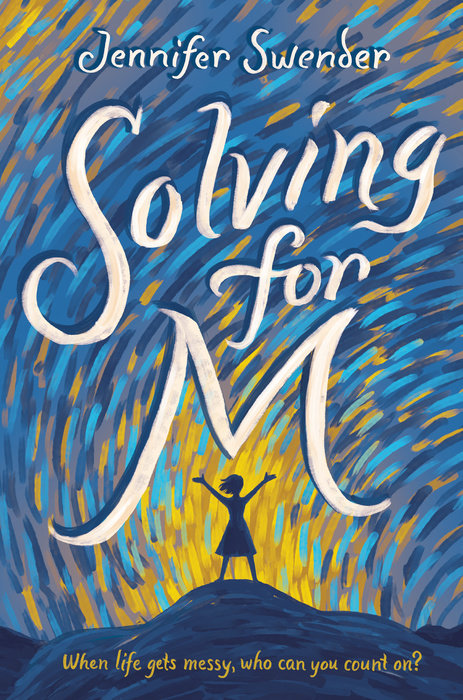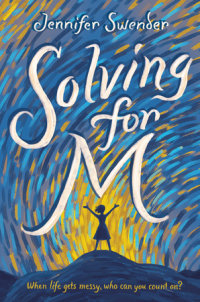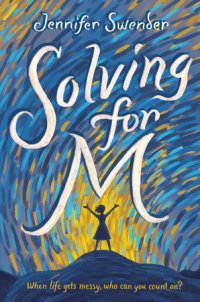Solving for M
Perfect for fans of Raymie Nightingale and The Fourteenth Goldfish, this heartfelt middle-grade novel seamlessly melds STEAM content with first loss in an honest and striking debut.
When Mika starts fifth grade at the middle school, her neat life gets messy. Separated from old friends and starting new classes, Mika is far from her comfort zone. And math class is the most confusing of all, especially when her teacher Mr. Vann assigns math journals. Art in math? Who's ever heard of such a thing?
But when challenges arise at home, Mika realizes there are no easy answers. Maybe, with some help from friends, family, and one unique teacher, a math journal can help her work out problems, and not just the math ones.
Debut author Jennifer Swender delivers poignant prose and illustrator Jennifer Naalchigar brings Mika's journal to life in this perfect equation of honesty plus hope that adds up to a heartwarming coming-of-age story.
An Excerpt fromSolving for M
Fifth grade at the middle school should make perfect sense. Elementary school is first grade, second grade, third, and fourth. (Okay, I know I’m leaving out kindergarten, but stick with me for a second.) Then middle school is fifth, sixth, seventh, and eighth. High school—ninth,
tenth, eleventh, and twelfth.
Twelve grades divided by three schools gives you four grades per school, with middle school smack dab in the . . . well, middle. Everything nice and logical.
But now, on the first day, I’m not so sure.
First of all, we have to keep a journal . . . in math?
Dan P. raises his hand. “Aren’t journals supposed to be for language arts?” he asks with a smirk. “Or Gothy kids who want to be poets?”
I know Dan well. He was in my class last year.
Mr. Vann, the math teacher, doesn’t say anything as he writes on the board: Bring in spiral notebook for your math journal. This step is mandatory. Then he turns back around to the class with a dramatic flourish.
Mr. Vann reminds me of some kind of wacky magician. A cape and top hat would not seem entirely out of the question. He wears these thick glasses that make his eyes look very big and very far away at the same time. And he’s left-handed, which means he can write on the board with his left hand as he erases the board with his right. The letters look like they’re running to fill up the newly emptied space.
I’m not exactly sure why we need a math journal, but it’s not the kind of question I’m going to raise my hand and ask on the first day of middle school. I’ll leave that to Dan.
“Why do we need a math journal?” Dan calls out. “Keeping a math journal will help us transparently
tackle innovative problems,” Mr. Vann begins. “Keeping a math journal will let us embark on reflective discussions of relevant math issues.” He underlines math journal on the board every time he says it. “Keeping a math journal will allow us to explore, justify, argue, wonder. . . .”
Well, okay then. I guess that’s why you need a math journal. Mr. Vann seems very excited by the whole idea. I bet when Mr. Vann was in fifth grade he kept a math journal without even being asked to. Maybe he invented the math journal.
It’s not that I have anything against math. I’m just not much of a math person. It doesn’t seem like something to get that excited about. Numbers are numbers, right?
My mom says she likes numbers because you always know what you’re going to get with them. She’s an accountant, so I guess she should know.
And it’s not that I have anything against journals, either. I have like twenty blank books at home. Some are full; some are empty. Some have pages torn out; some have pages stuffed in. But those are for art, not for math. “Keeping a math journal will allow us to dare to color
outside the lines,” Mr. Vann adds. Then he spins back around to write something else on the board: Bring in colored pencils and/or markers for your math journal. This step is optional.
I guess he wasn’t kidding about the coloring part. And I can get excited about anything that involves colored pencils and/or markers—drawing, doodling, sketching. I can do horses really well, and I’m pretty good at people, too. I have a book that shows how to draw things in a certain number of steps. You just follow the directions and everything turns out the way it’s supposed to.
“What do we need colored pencils for?” Dan asks. “Patience, please, my dear Watson,” Mr. Vann says.
Then he opens the top drawer of his desk and takes out a box of matches. I’m half expecting him to light a pipe. But instead, he reaches into the drawer again and takes out what looks like a white tea candle.
Is he allowed to have candles and matches in school? I’m pretty sure that’s got to be against the middle school rules.
Mr. Vann dramatically strikes the match on the box and lights the candle. “Remember, dear thinkers,” he says. “Math may be exact.”
Then he blows out the candle, pops it into his mouth, and eats it.
“But life is mostly estimation.”
Before anyone can say anything, the bell rings (although the middle school bell sounds more like a horn), and Mr. Vann dismisses us to the auditorium. There’s a welcome assembly for the fifth grade.
Am I the only one thinking that first thing this morning might have been a better time for a welcome assembly? Anyway, we all file in and find our seats.
Principal Mir walks to the microphone. You can hear her shoes going click, click, click across the shiny floor.
Principal Mir is a small woman, but she has the look of someone you do not want to mess with. She’s wearing a matching plaid skirt and jacket and very sensible shoes. “Welcome to Highbridge Middle School,” she begins. “Pride of the Upper Hudson Valley. We hope you had no trouble finding your pods this morning.”
I should explain that a pod is a team of teachers, all in the same hallway. My mom says they put the fifth graders into pods to make the middle school feel smaller and less overwhelming.
I suddenly get this funny picture in my mind of all of us fifth graders as space aliens who have just arrived on this strange new planet called Highbridge Middle. Luckily, we have our home pods to make us feel safe and cozy. Across the auditorium, I see Ella, my best friend from fourth grade. I wave to her, but she’s whispering to the girl sitting next to her and doesn’t see me.
I’m in Pod Two. Ella is in Pod One. I guess we can still probably eat lunch together, but besides that, we’re on totally opposite ends of the building for the whole day. So even though the pods are supposed to make you feel safe and cozy, they mostly make you feel like your friends are far away.



